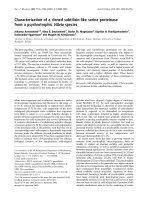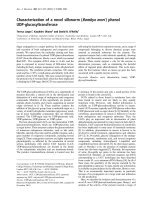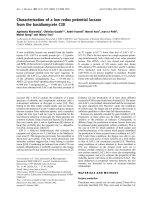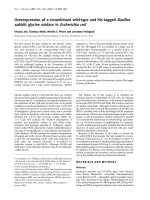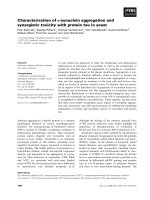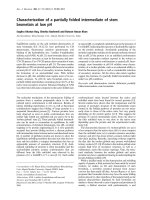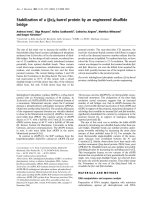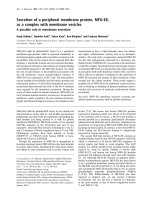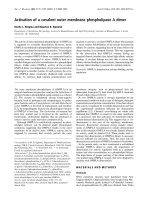Báo cáo Y học: Overexpression of a recombinant wild-type and His-tagged Bacillus subtilis glycine oxidase in Escherichia coli pptx
Bạn đang xem bản rút gọn của tài liệu. Xem và tải ngay bản đầy đủ của tài liệu tại đây (332.62 KB, 8 trang )
Overexpression of a recombinant wild-type and His-tagged
Bacillus
subtilis
glycine oxidase in
Escherichia coli
Viviana Job, Gianluca Molla, Mirella S. Pilone and Loredano Pollegioni
Department of Structural and Functional Biology, University of Insubria, Varese, Italy
We have cloned the gene coding for t he Bacillus subtilis
glycine oxidase (GO), a new flavoprotein that oxidizes gly-
cine and sarcosine to the corresponding a-keto a cid,
ammonia a nd hydrogen peroxide. By inserting the DNA
encoding for GO into the multiple cloning site of the
expression vector pT7.7 we produced a recombinant plasmid
(pT7-GO). The pT7-GO encodes a fully active fusion protein
with six additional residues at the N-terminus of GO
(MARIRA). In BL21( DE3)pLysS Escherichia coli cells, and
under optimal isopropyl thio-b-
D
-galactoside induction
conditions, soluble and active chimeric GO was e xpressed up
to 1.14 U g
)1
of cell (and a fermentation yield of 3.82 UÆL
)1
of fermentation broth). A n N-terminal His-tagged protein
(HisGO) w as also successfully expressed in E. coli as a
soluble protein and a fully active holoenzyme. HisGO
represents 3.9% of the total soluble protein content o f t he
cell. The His-tagged GO was purified in a single step by
nickel-chelate chromatography to a specific activity of
1.06 UÆmg
)1
protein at 2 5 °C and with a yield of 98%. The
characterization of the purified enzyme showed that GO is a
homotetramer of 180 kDa with the spectral properties
typical of flavoproteins. G O exhibits good thermal s tability,
with a T
m
of 46 °C a fter 30 min incubation; its stability is
maximal in the 7.0–8.5 pH range. A comparison of amino-
acid sequence and substrate specificity indicates t hat GO h as
similarities to other flavoenzymes acting on primary amines
and on
D
-amino acids.
Keywords: g lycine oxidase; flavoprotein; oxidase; His-tagged
protein; purification.
Glycine oxidase (GO) is a flavoenzyme that was recently
discovered followi ng the complete sequencing of the Bacillus
subtilis genome [1]. A preliminary i nvestigation reported o n
the e xpression o f the yjbR gene product and on its partial
purification and characterization in Escherichia coli [2]. GO
was found to be active on various amines such as sarcosine,
N-ethylglycine, glycine and
D
-amino acids, and to partially
share substrate specificity with both
D
-amino-acid oxidase
(DAAO, EC 1.4.3.3) and sarcosine oxidase (SOX, EC
1.5.3.1) [2]. GO ca taly zes the o xidative de amination o f
primary and secondary amines to give a-keto acids,
ammonia and hydrogen peroxide (L. Pollegioni, unpub-
lished r esults). SOX catalyses the o xidative demethylati on of
sarcosine (N-methylglycine) to form glycine and formalde-
hyde. Similarly, DAAO catalyses the oxidative d eamination
of neutral and (with a lower efficiency) basic
D
-amino acids
to give the corresponding a-keto acids and ammonia. In
both cases, the reduced coenzyme is re-oxidized by
molecular oxygen to yield H
2
O
2
. Although DAAO and
SOX s how a wide s ubstrate t olerance, they do not efficiently
oxidize glycine.
The present aim of this project is to elucidate the
structure–function relationships in GO, with the ultimate
goal of clarifying the modulation of the substrate specificity
in enzymes (GO, DAAO and SOX) that catalyse reactions
on similar compounds. Although extensive information on
the functional and structural characteristics of DAAO and
SOX is available, there is little knowledge of GO p roperties
and reactions. There is also a biotechnological aspect to this
project, as the stereoselective reaction catalysed by DAAO
is of considerable importance in biotechnology and indus-
try, e.g. the bioconversion of cephalosporin C to glutaryl-
7-amino cephalosporanic acid [3,4]. Industrial interest i n t he
discovery of amino-acid oxidase activities with new, wider
substrate specificity is increasing.
Because of the relevance of this topic, we cloned the
B. subtilis DNA that encodes GO and studied the overex-
pression of this enzyme in E. coli. I n t his p aper we report on
two expression systems f or obtaining fairlylarge quantities o f
a r ecombinant chimeric G O from E. coli cells and a quicker,
high-yield procedure for the p u rification of this flavoenzyme.
In addition, the physical and chemical characteristics, the
activity on glycine and sarcosine, and the substrate specifi-
city of the purified enzyme have been characterized.
MATERIALS AND METHODS
Materials
Restriction enzymes and T 4 DNA ligase were o btained
from Roche Diagnostics. Ampicillin, chloramphenicol,
Luria–Bertani broth, o-dianisidine and horseradish peroxi-
dase were purchased from Sigma. DEAE-Sepharose Fast
Flow, phenyl-Sepharose CL-4B, Superdex 200, HiTrap Che-
lating and PD10 prepacked columns were from Amersham
Correspondence t o L. Pollegioni, Dipartimento di Biologia Strutturale
e Funzionale, Universita
`
degli Studi dell’Insubria via J.H. Dunant 3 ,
21100 Varese, Italy. Fax: + 332 421500, Tel.: + 332 421506,
E-mail:
Abbreviations: GO, glycine oxidase; TSOX, heterotetrameric sarcosine
oxidase; MSOX, monomeric sarcosine oxidase; DAAO,
D
-amino-acid
oxidase; DASPO,
D
-aspartate oxidase; DMGDH, dimethylglycine
dehydrogenase; SDH, sarcosine dehydrogenase; PIPOX, pipecolate
oxidase; INT, iodonitrotetrazolium chloride.
(Received 23 O ctober 2001, revised 7 January 2002, accepted 16
January 2002)
Eur. J. Biochem. 269, 1456–1463 (2002) Ó FEBS 2002
Pharmacia Biotech and hydroxyapatite was from Bio-Gel-
HTP. All purification steps were p erformed using a n
A
¨
KTA-FPLC system (Amersham Pharmacia Biotech).
The plasmid DNA was extracte d and purified from E. coli
cells using the FlexiPrep Kit and the DNA was extracted
from the gel us ing the Sephaglass BandPrep K it (Amersham
Pharmacia Biotech). The pT7.7A plasmid was from USB;
BL21(DE3)pLysS E. coli cells were from Novagen Inc.
Assay for GO activity
GO activity was assayed using a Hansatech oxygen
electrode equipped with a thermostat to measure the oxygen
consumption at p H 8.5 and 25 °Cwith10m
M
sarcosine as
substrate. One unit of GO is defined as the amount of
enzyme that converts 1 lmol of substrate (sarcosine or
oxygen) per minute at 25 °C. The pH effect on GO activity
and s tability was dete rmined using a multicomponent
buffer: 15 m
M
Tris, 15 m
M
sodium carbonate, 1 5 m
M
phosphoric acid, 250 m
M
potassium chloride and 1% (v/v)
glycerol. The high [KCl] was used to buffer against minor
changes i n ionic strength at different pH values. These
buffers were adjusted to the appropriate pH with HCl or
KOH. To assess the pH stability, activity was determined
30 min after incubation at the different pH values. For
thermal inactivation, GO samples in 50 m
M
potassium
phosphate buffer, pH 7.0, containing 10% (v/v) glycerol
were incubated in a temperat ure range of 4–6 0 °C. Aliquots
were withdrawn after 30 min of incubation and a ssayed for
GO activity. Protein concentration was measured using the
Bradford protein assay.
Cloning of
B. subtilis
GO cDNA and DNA manipulation
The cloning an d transformation techniques u sed were
essentially those described by Sambrook et al.[5].Genomic
DNA from B. subtilis cells strain B168 was a generous gift
of A. Galizzi (Universita
`
di Pavia, Italy ). PCR amplification
of the yjbR gene encoding GO was obtained using Vent
R
DNA polymerase ( New England BioLabs) and t he fol-
lowing oligonucleotides: YJBr-up (5¢-GCCAT
GAATTC
GCGCTATGAAAAGGCATTATGAAGCAGTGG-3¢)
derived from the 5¢ end and YJBr-down (5¢-CCGAT
GAATTCCATCATATCTGAACCGCCTCCTTGCG-3¢)
derived from the 3¢ end of nucleotide sequ ence of yjbR gene
(the sequence recognized by EcoRI restriction enzyme is
underlined). This amplification yielded a product of
1139 bp representing the entire GO gene. The PCR p roduct
was digested with t he restriction enzyme EcoRI, i solated by
agarose gel electrophoresis and inserted i n the unique EcoRI
site of the multiple cloning site of the expression vector
pT7.7 downstream of t he T7 RNA polymeras e promoter t o
produce the recombinant p lasmid pT7-GO. The correct
orientation of the insert was checked by restriction digestion
with the e nzyme HindIII. Both strands of the resulting
plasmid were automatically sequenced: the nucleotide
sequence was identical to t he known sequence of the yjbR
gene [1].
Expression and purification of GO in
E. coli
The pT7-GO expression plasmid was amplified in t he E. co li
strain JM109 and then transferred, for p rotein production,
to the host BL21(DE3)pLysS E. coli strain. Cells carrying
the recombinant plasmid were grown at 37 °CinLuria–
Bertani, 2 · Luria–Bertani, 2 · YT [5] or terrific broth
media containing ampicillin (100 lgÆmL
)1
final concentra-
tion) and c hloramphenicol (34 lgÆmL
)1
final concentra-
tion), and induced at selected D
600
values by adding
isopropyl thio-b-
D
-galactoside. After induction, the cells
were grown at 30 °C and collected at various times (from 1
to 24 h) by centrifugation. Crude extracts were prepared by
French Press lysis (three cycles at 1000 p.s.i.) of cell
suspensions obtained by r e-suspending the frozen cell paste
with 50 m
M
sodium pyrophosphate buffer, pH 8.5, con-
taining 5 m
M
EDTA, 0.2 l
M
FAD, 5 m
M
2-mercaptoeth-
anol, 0.7 lgÆmL
)1
pepstatin, 1 m
M
phenylmethanesulfonyl
fluoride and 10 lgÆmL
)1
DNase (in a ratio of 2–3 mL of
lysis buffer per gram of E. coli cells). The i nsoluble fraction
of the l ysate w as removed by centrifugation a t 39 000 g for
40 min at 4 °C.
The cell homogenate, obtained by French P ress lysis of
34 g of E. coli cells under the conditions reported a bove,
was precipitated with ammonium sulfate at 30% of
saturation (164 gÆL
)1
). The supernantant was then brought
to 45% of saturation (86 gÆL
)1
). After centrifugation, the
protein pellet was re-suspended a nd dialysed against 5 0 m
M
potassium phosphate buffer, pH 7.0, 2 m
M
EDTA, 1 0%
glycerol a nd 5 m
M
2-mercaptoethanol (buffer A). After
dialysis and c entrifugation, the enzyme solution w as ap plied
to a DEAE-Sepharose Fast-Flow c olumn (1.6 · 21 cm)
and eluted with a 10–20% linear gradient using buffer A to
which 1
M
NaCl was added. Fractions containing GO
activity were pooled and concentrated using a n Amicon cell
concentrator equipped with a YM30 membrane. The
sample was then loaded onto a hydroxyapatite column
(1.6 · 12 cm) and GO eluted, using a 50 m
M
potassium
phosphate buffer, pH 6.5, 2 m
M
EDTA and 10% glycerol.
The f ractions containing GO activity were pooled and the
pH was adjusted with sodium carbonate to pH 7.5. After
the addition of 0.5
M
sodium chloride (final concentration)
the sample was applied to a phenyl-Sepharose CL-4B
column (1.6 · 22 cm) equilibrated in 50 m
M
potassium
phosphate buffer, pH 7.5, 0.5
M
sodium chloride, 2 m
M
EDTA, and 5 m
M
2-mercaptoethanol. The boun d enzyme
was s ubsequently eluted with 50 m
M
potassium phosphate,
pH 7.5, 5 m
M
2-mercaptoethanol and 2 m
M
EDTA. The
fractions containing GO activity were concentrated and
stored at )20 °C.
HisGO preparation, expression and purification
The G O DNA obtained by EcoRI digestion of the original
pT7-GO plasmid (see above) was inserted into the EcoRI
site of the pT7-DBam/Hind plasmid [6]. The resulting
recombinant plasmid, defined as pT7-HisGO, encodes for
an additional N -terminal sequence c ontaining one methi-
onine and six histidine residues (Fig. 1). The correct
insertion of the GO gene was checked by digestion with
the restriction enzymes NdeIandBamHI/ScaI and by a
PCR reaction, using the XbaI [6] and YJBr-down oligonu-
cleotidesasaprimer.
The pT7-HisGO expression plasmid was transferred
to the host BL21(DE3)pLysS E. coli strain for protein
production. Recombinan t cells were grown at 3 7 °Cin
2 · Luria–Bertani medium containing ampicillin and
Ó FEBS 2002 A His-tagged chimeric glycine oxidase (Eur. J. Biochem. 269) 1457
chloramphenicol (100 lgÆmL
)1
and 34 lgÆmL
)1
final con-
centration, respectively) and induced at D
600
¼ 0.8 by
adding isopropyl thio-b-
D
-galactoside at a final concentra-
tion of 1 m
M
. The cells were then grown at 30 °Cand
collected after 24 h by centrifugation. Crude extracts
(prepared as described above) were added of 1
M
NaCl
and 1 m
M
imidazole (all final concentrations) to improve
the interaction specificity in the affinity chromatography
step. The enzyme solution w as then applied to a HiTrap
chelating affinity column (5 mL) equilibrated with 50 m
M
sodium pyrophosphate buffer, pH 7.2, containing 1
M
NaCl, 20 m
M
imidazole and 5% glycerol, using an
A
¨
KTA-FPLC system. The bound enzyme was eluted with
50 m
M
sodium pyrophosphate buffer, pH 7.2, containing
500 m
M
imidazole and 5% glycerol (elution buffer). The
fractions c ontaining GO activity were pooled and l oaded o n
a PD10 column equilibrated with 5 0 m
M
sodium pyro-
phosphate b uffer, pH 8.5, containing 2 m
M
EDTA, 5 m
M
2-mercaptoethanol and 10% glycerol.
Substrate specificity
Two d ifferent methods were u sed to i nvestigate the substr ate
specificity of GO.
Activity stain using iodonitrotetrazolium chloride (INT)
on protein samples separated by native PAGE. After the
electrophoretic separation, each single lane was incubated
for2hinthedarkat37°C in a solutio n containing 75 m
M
sodium pyrophosphate, pH 8.5, 100 m
M
substrate, 5 l
M
FAD a nd 0.1 mgÆmL
)1
INT (dissolved in pure ethanol).
The activity was revealed as a pink band on the gel in the
position corresponding to the G O.
Spectrophotometric determination of GO activity meas-
uring the hydrogen peroxide produced in the presence of
different substrates using a 96-well ELISA plate. Each
assay well has 200 lL of a solution containing 10 m
M
or
90 m
M
substrate, 0.32 mgÆmL
)1
o-dianisidine and
10 UÆmL
)1
of horseradish peroxidase in 90 m
M
sodium
pyrophosphate, pH 8.5. The increase in absorbance at
440 nm was followed using a Mete rtech 960 spectropho-
tometer (extinction coefficient of o-dianisidine product was
13 m
M
)1
Æcm
)1
).
Western blot analysis, N-terminal sequencing
and sequence comparison
Western blot analysis was performed on total E. coli and
crude protein extracts. Proteins were separated on 12%
SDS/PAGE [7] and transferred electrophoretically to
nitrocellulose membranes (Millipore) [8]. GO was detected
by immunostaining using rabbit anti-GO Ig and visual-
ized using anti-(rabbit IgG) Ig alkaline phosphatase
conjugate with 5-bromo-4-chloro-3-indolyl phosphate
and nitro-blue-tetrazolium chloride. The anti-GO Ig were
raised in rabbit with 0 .5 mg of pure GO a s antigen
according to a standard protocol (Davids Biotechnologie,
Germany). The N-terminal sequence of the recombinant
GO was determined on a purified soluble protein sample
using an automated protein sequencer (Procise Model
492, Applied Biosystems). The
BLAST
program (http://
www.ncbi.nlm.nih.gov/blast/Blast.cgi) [9] was used to
search for proteins showing sequence similarity. Multiple
sequence alignments were performed with the
CLUSTALW
program ( />[10].
RESULTS
Cloning of
B. subtilis
GO DNA and protein sequence
comparison
To clone the gene encoding the B. subtilis GO, the genomic
DNA was amplified by PCR using the oligonucleotides
derived from the sequence of the yjbR gene of GO from
B. subtilis [1]. Currently, t here are three proteins in the
nonredundant Protein Data B ank that have been classified
asGO.InadditiontotheenzymefromB. subtilis,the
proteins from Bacillus halodurans and Thermoplas ma
volcanium (accession nos BAB05153 and NP_111169,
respectively) have been also included in the database. The
overall sequence identity w ith B. subtilis GO is modest
(27% an d 22%, respectively), although a higher conserva-
tion is evident at their N-termini (containing the Rossman
fold fingerprint m otif GXGXXG, w hich is in volved in
binding of the ADP moiety of FAD) [11] and for the 70
residues at their C-termini (for th is latter region a 31–40%
of identity and a 53–61% of sequence similarity has been
calculated).
The r esults of comparison of the amino-acid sequence of
B. subtilis GO with the sequences available in the Data
Bank are reported in Table 1. The greatest similarity was
found between GO and the b subunit of heterotetrameric
sarcosine oxidase (TSOX), sarcosine dehydrogenase ( SDH)
and dimethylglycine dehydrogenase (DMGDH). In all
cases, the N-terminal region corresponds to the flavin-
binding domain a nd shows the highest sequence conserva-
tion (3 2–48% of identity when only the starting 50 residues
Fig. 1 . Physical map of the Bacillus subtilis GO expression plasmid
pT7-HisGO . The1.13kbofGOcDNAwasinsertedintotheEco RI
site of the MCS of pT7- DBam/Hind plasmid [6]. The original ATG
starting codon is shown in b old and the ATG c odon corresponding to
the Met1 of t he wi ld- type G O in it al ic.
1458 V. Job et al. (Eur. J. Biochem. 269) Ó FEBS 2002
are considered). A considerable homology was also
observed with the sequences of monomeric sarcosine
oxidases (MSOX), pipecolate oxidase (PIPOX), DAAO
and
D
-aspartate oxidase (DASPO). P IPOX is a m ammalian
enzyme that plays a significant role in brain metabolism,
where
L
-pipecolate acts as a neuromodulator. DAAO has
been proposed to regulate the levels of
D
-serine in b rain, a
D
-amino acid that modulates NMDA neurotransmission. A
partial sequence comparison between GO and SOX or
DAAO proteins [12,13] of t he regions containing the h ighly
conserved residues that play a key role in catalysis is
reportedinFig.2A,B.
Table 1.
BLAST
results o f s earch for ide ntity an d homology with B. subtilis GO. The p ercentages refer t o t he 369 amino acids of GO. Th e h omology
score is considered the sum of identical and s trongly similar a mino acids. Th e proteins i dentifi ed by the code ÔNP_Õ have been recognized following
the complete sequence of the genome of the correspon ding organism; therefore, their activity was never proven. TSOX, b subunit of hetero-
tetrameric sarcosine oxidase.
Entry code Organism Protein Identity (%) Homology (%)
BAB05153 Bacillus halodurans GO 27 51.8
NP_111169 Thermoplasma volcanium GO 21.7 48.0
NP_107418 Mesorhizobium loti TSOX 24.4 45.5
NP_126006 Pyrococcus abyssi TSOX 26.8 49.9
P40875 Corynebacterium sp. P-1 TSOX 23.8 48.8
P23342 Bacillus sp. NS-129 MSOX 21 43
P40859 Bacillus sp. B-0618 MSOX 20.6 43.4
P24552 Fusarium solani DAAO 18.4 39.3
P80324 Rhodotorula gracilis DAAO 18.4 38
P31228 Bos taurus DASPO 18.4 39
Q63342 Mus musculus DMGDH 24.7 49
NP_106044 Mesorhizobium loti SDH 27.6 49.6
NP_057602 Homo sapiens PIPOX 21.4 46.9
Fig. 2. Details of the multiple sequence alignment f or GO from B. subtilis with sequences of S OX (A) and DAAO (B) and comparison of the 3D
structure o f t he active site with those o f other enzymes (C). Residues marked with (*) i ndicate identity (
:) indicate strongly similar, and ( .)indicate
weakly si milar. The b oxes identify the amino acids present in the active s ite of M SOX [12] and of DAAO [15,16]. (C) C omparison of t he active site
ofthe3D-structuremodelofGOwiththeactivesiteofMSOXfromBacillus subtilis (right) [12] a nd D A AO f rom Rh odotorula gracilis (left) [15].
Ó FEBS 2002 A His-tagged chimeric glycine oxidase (Eur. J. Biochem. 269) 1459
Using the Swiss-Model software at the
EXPASY
website
[14], a model of the 3D structure of G O has been predicted
using its protein sequence and the 3D coordinates of
Rhodotorula g racilis DAAO as template [15]. D ue to the
limited sequence homology between these t wo enzymes, the
GO model only extends from Y240 to G313. A comparison
of the active s ites of MSOX and D AAO with the active site
of the model derived for GO ( Fig. 2C) confirms that Y246 is
highly c onserved and is located a t a position resembling that
of Y223 in DAAO and Y254 in MSOX. Even the arginine
residue (R285 in yeast D AAO) which e lectrostatically
interacts with t he a-carboxylate of the
D
-amino acid in
DAAO [15,16] is conserved in GO (R302, see Fig. 2C). On
the other hand, and according to the sequence comparison,
M261 in GO appears t o be located at the position occupied
by Y238 and H 269 in DA AO and MSOX, respectively. This
second active site residue, which is involved in the recog-
nition/binding of the substrate in both MSOX a nd DAAO
[12,15], is not conserved in GO and probably represents a
key element for defining its substrate specificity.
The limited (sequence) similarity/homology between GO,
DAAO, MSOX and TSOX is also confirmed by t he results
obtained in Western blot experiments using monospecific
anti-DAAO [17] and a nti-GO Ig. The antibodies raised
against pure B. subtilis GO did not recognize DAAO a nd
MSOX (a faint band is only observed when a large amount
of TSOX is used, data not shown). Analogously, anti-
DAAO IgG did not recognize GO, MSOX or TSOX.
Expression of
B. subtilis
GO gene in
E. coli
and
GO purification
The DNA encoding for G O was inserted in the EcoRI site
of the multiple cloning site of the expression vector pT7.7
downstream of the T7 RNA polymerase promoter to
produce the recombinant plasmid pT7-GO. Because of the
presence of an ATG c odon upstream of the cloning site, t his
procedure produces a fusion protein; six additional residues
are a dded a t t he N-terminus of the protein before the
original starting methionin e. The new ATG starting codon
is positioned 8 bp downstream from the ribosomal binding
site. The recombinant plasmid pT7-GO was used to
transform BL2 1(DE3)pLysS E. coli cells. A significant
increase in GO synthesis was observed immediately after
the addition of 1 m
M
isopropyl thio-b-
D
-galactoside in cell
cultures transformed with the pT7-GO expression vector
and grown on Luria–Bertani m edium, as indicated by native
PAGE and GO activity staining. The highest level of GO
expression and GO specific activity was obtained 24 h after
induction in the mid-log growth phase of a c ulture grown on
Luria–Bertani medium. No activity was detected in E. coli
extracts from cells carrying the vector without the 1.13-kb
GO DNA (data not shown). The GO expression depends
on the isopropyl thio-b-
D
-galactoside concentration: West-
ern blot experiments show that the maximal amount of
immunoreactive GO in soluble crude extract, as well as in
the total cell, was achieved at a n isopropyl thio-b-
D
-
galactoside concentration o f 0.5 m
M
. Analogously, the
higher GO fermentation yield (in terms of GO units per
gram of cell p aste and GO s pecific activity) was obtained at
the same concentration of inducer (data not shown). A
comparison of the amount of immunoreactive GO in the
total cell with the amount of GO in the crude extract on
Western b lot indicates t hat GO is almost t otally expressed i n
a soluble form. Under the best conditions, the GO
expression reached 1UÆg
)1
cell and 4 U ÆL
)1
of fermen-
tation broth (with a G O specific activity in the crude extract
of 0.006 UÆmg
)1
protein). GO accumulated to 1% of total
E. coli soluble proteins in the crude extract.
Recombinant GO was purified from E. coli cells by
precipitation with ammonium sulfate twice and then a
three-step chromatography procedure (see Materials and
methods). Ab out 13 mg of enzyme (90% homogenous)
were obtained starting from 3 4 g of cell paste (Table 2).
The total yield of the purification was about 20%. The
N-terminal sequence of the first eight amino acid s of the
recombinant GO was determined. This sequence is unique
and was identical to that inferred from the nucleotide
sequence [1]; protein sequencing o f 0.2 nmol of the purified
enzyme resulte d in the A RIRAMKR s equence, confirming
the presence of five of the six additional residues at the
N-terminus of recombinant chimeric GO (the starting
methionine is not present).
The recombinant GO produced in E. coli was purified
as a holoenzyme with spectral p roperties typical of the
flavin-containing oxidases (absorbance maxima at 457 nm
and 376 nm and a A
274
/A
456
¼ 9). Na tive GO is a
180-kDa homotetramer, as determined by SDS/PAGE
(46.6 ± 1.3 kDa) and gel permeation chromatography on
a Superdex 200 column (187.6 ± 2.3 kDa). The recombin-
ant enzyme catalysed the oxidation of sarcosine and glycine
(specific activity of 0.57 and 0 .43 UÆmg
)1
protein, at 25 °C).
Table 2. Purifica tion of recombinant B. subtilis glycine oxidase from BL21(DE3)pLysS E. coli cells c ontai ning the pT7-GO (top) a nd pT7-HisGO
(bottom) plasmid. Starting material was 34 g of E. coli c ell paste obtaine d from a 10-L fe rmentation (GO ) and 38 g of E. coli cell paste obtained from
a 6-l fermentation (HisGO).
Step
GO activity
(U)
Protein content
(mg)
Specific activity
(UÆmg protein
)1
)
Purification
index
Yield
(%)
GO
Crude extract 38.2 6617 0.006 1.0 100
(NH
4
)
2
SO
4
precipitation 25.0 2984 0.008 1.4 65.4
DEAE-Sepharose 23.4 512 0.046 7.9 61.3
Hydroxyapatite 14.6 112 0.130 22.4 38.1
Phenyl-Sepharose 7.5 13.1 0.568 98.0 19.5
HisGO
Crude extract 86.6 2188 0.039 1.0 100
HiTrap Chelating 86.3 80 1.06 27.2 98
1460 V. Job et al. (Eur. J. Biochem. 269) Ó FEBS 2002
Addition of exogenous FAD or FMN to the assay mixture
did not increase enzyme activity, indicating a tight binding
of the coenzyme to t he protein moiety.
Preparation, overexpression and purification
of the chimeric His-tagged GO
The scheme of the strategy devised for obtaining a plasmid
coding for the chimeric His-tagged GO is reported in the
Materials and methods section; the map of the resulting
expression vector pT7-HisGO is given in Fig. 1. In these
experiments the conditions for the expression of GO in
E. coli BL21(DE3)pLysS cells were optimized. Cells were
grown at 37 °C and induced with 1 m
M
isopropyl thio-b-
D
-
galactoside at an D
600
¼ 0.8; the growth temperature was
then decreased to 30 °C a nd the cells were harvested 24 h
after induction. The protein was overexpressed under the
reported co nditions and was totally soluble and thus
recovered in the crude extract. In addition, the chimeric
HisGO was entirely present as an active holoenzyme.
Therefore, the addition o f exogenous FAD o r FMN to the
assay m ixture did n ot increase the activity a t all. The enzyme
expression was about 1 UÆg
)1
of wet weight ( 2.1 mg
GO/gofwetweightcelland 4% of t otal E. coli soluble
proteins in the crude extract) and the fermentation yield w as
14.4 UÆL
)1
per culture.
The c rude extract from induced E. coli cells was loaded
onto a HiTrap chelating affinity column following the
addition of 1
M
sodium chloride and 1 m
M
imidazole (all
final concentrations). Under the elution conditions we
employed (see Materials and methods), the engineered G O
was selectively e luted as a single resolved peak (data not
shown). The final preparation was 95% homogeneous. The
sequence analysis (MHHHHHHMARIRA) of the purified
enzyme confirmed the presence of the basic additional
sequence (the starting methionine plus the six histidine tag
plus the additional s ix residues of the chimeric protein) at
the N-terminus, which clearly does not impair either the
enzymatic activity or the coenzyme binding.
The purification of the His-tagged chimeric GO and, for
comparison, that of the wild-type enzyme is reported in
Table 2 . From this table it is apparent that the purification
procedure of t he engineered GO is far less time-consuming
(the final G O preparation is obtained in few hours s tarting
from the E. coli cell paste). Rema rkably, a nd due to the fast
procedure used, we obtained a f ully active holoenzyme with
a specific activity that was twofold higher than that of the
wild-type recombinant enzyme (1.06 vs. 0.57 UÆmg
)1
pro-
tein). In addition, the total recovered enzyme a ctivity
obtained starting from a similar amount of E. coli cell paste
are higher for the HisGO than for the wild-type enzyme.
Properties of the His-tagged chimeric GO
The molecular mass of HisGO, as determined by SDS/
PAGE, is slightly higher than the value calculated from
the amino-acid sequence (49.4 ± 1.1 k Da vs. 42.66 kDa,
respectively). U nder native conditions, the molecular mass
of the His-tagged GO is 166.4 ± 11.1 kDa, as determined
by gel permeation chromatography. The elution volume
(R
t
¼ 13.4 ± 0.2 mL) is not dependent on the protein
concentration in the range 0.01–12 mgÆmL
)1
. T he result is
consistent with the presence in solution of a stable
homotetramer. The theoretical isoelectric points of GO
and HisGO are 6.14 and 6.34, respectively. However, we
were not able to determine this under any of the present
experimental conditions due to the instability of the protein
at a pH < 7 (see below). The purified holoenzyme shows
the typical absorbance spectrum of F AD-containing
proteins, with two well-resolved peaks in the visible region
(at 458 nm and 378 nm, see Fig. 3). Anaerobic addition of
an excess of glycine resulted instantaneously in the forma-
tion of reduced enzyme flavin, as shown by its spectrum
with a maximum at 346 nm (Fig. 3). The spectral p roperties
of oxidized and reduced recombinant GO are significantly
different from those previously reported, e.g. the reported
flavin reduction following addition of 10 m
M
sarcosine
resulted in a 20% decrease of the 455 nm peak [2], which
is not compatible with full flavin reduction.
Plotting GO activity (on sarcosine as substrate and using
both GO a nd HisGO ) over t he t emperature ra nge 15–60 °C
shows an increase in a ctivity with no evidence f or any
plateau or decrease up to 60 °C (Fig. 4A). HisGO shows
good temperature stability in t he range 4–35 °C when the
samples are incubated for 30 min at pH 7 .0. When the
temperature is increased to above 35 °C, however, a sharp
decrease in enzyme stability is evident (Fig. 4A): a T
m
of
46 °C was seen. T he activity is maximal a t a bout pH 10, but
falls off rapidly above pH 10, probably due to instability
(Fig. 4B). The stability is maximal in the 7–8.5 pH range.
Below pH 6.5 and above pH 9.5, a considerable decrease in
stability was observed (Fig. 4B). These profiles were iden-
tical when GO was used instead of HisGO (data not
shown). Both GO and HisGO enzymes are stable for
months when stored at )80 °CandatapH ¼ 7.5.
Substrate specificity
Purified GO shows a similar specific activity on sarcosine
and glycine as substrates (1.06 and 1.00 UÆmg
)1
protein,
respectively). Because of the sequence similarity of GO with
Fig. 3. Absorbance spectrum of the purified HisGO ( 12 l
M
)inthe
oxidized form (1) and in the reduced form (2), as obtained under
anaerobic conditions by t he addition of 20 m
M
glycine in 5 0 m
M
potas-
sium phosphate buffer pH 7.0, 5 m
M
2-mercaptoethanol, 2 m
M
EDTA
and 10% glycerol.
Ó FEBS 2002 A His-tagged chimeric glycine oxidase (Eur. J. Biochem. 269) 1461
a number of flavoenzymes (see Table 1), the substrate
specificity of the reaction catalysed by GO has been
investigated using several compounds that are known to
be substrates of DAAO, DASPO, SOX, DMGDH and
PIPOX. Rapid s creening was performed by measuring the
increase in absorbance at 440 nm following the horseradish
peroxidase assay coupled with o-dianisidine using a 96-well
ELISA plate. The results, reported as a percentage with
respect to t he absorbance change observed with sarcosine as
100%, a re shown in Fig. 5. From t his it is evident that GO
possesses a wide substrate specificity. In addition to
sarcosine and glycine, even N-e thylglycine, ethylglycine
ester,
D
-alanine,
D
-2-aminobutyrate,
D
-proline,
D
-pipecolate
and N-methyl-
D
-alanine are good substrates; here, a lower
activity is observed on branched and polar
D
-amino acids
(e.g.
D
-Val,
D
-Ile,
D
-Leu,
D
-His, and
D
-Arg). GO is strictly
stereospecific as it only catalyses the oxidation of the
D
-isomer, as further demonstrated by the INT staining
assayreportedinFig.5,inset.
A comparison of t he activity measured u sing a similar
amount (5 mU) of GO, DAAO and MSOX on various
substrates showed that GO and DAAO oxidize
D
-proline,
D
-alanine and
D
-2-aminobutyrate with similar relative
efficiencies. Analogously, GO and MSOX show a fairly
similar activity o n s arcosine and N-ethylglycine. In contrast,
an appreciable activity on glycine, glycine-ester a nd
D
-pipecolic acid was only observed using GO. Interestingly,
D
-proline i s t he only amino acid in which the a-amino group
is involved in a covalent bond with the side chain and it is
the only compound that was oxidized by all three enzymes
used. I t i s also the only
D
-amino ac id that is oxidized
efficiently by both D AAO and
D
-aspartate oxidase [18].
CONCLUSIONS
The present data demonstrate the successful overexpression
of a chimeric B. subtilis GO in E. coli (upto3.9%oftotal
soluble protein) using two different expression systems. In
particular, we produced a recombinant GO c ontaining a
polyhistidine tag at the N-terminus, that can be effi ciently
purified in a single step by metal-chelate chromatography,
producing a stable holoenzyme with a high specific activity
and a 98% yield quickly and simply. Its properties
(aggregation state, absorbance spectrum and stability) are
identical to those of native GO, but the specific activity is
twofold higher. The spectral properties of GO in the
oxidized and r educed form (Fig. 3) unambiguously identify
it as a flavoenzyme. A comparison of the expression level
and purification yield obtained with the previo us procedure
[2] is not feasible because no quantitative data have been
previously reported.
Sequence comparison and Western blot analyses show
that GO is not highly similar to any known flavo-
enzyme, although the observed sequence homology a nd
Fig. 5. Assay of G O activity on a number of compounds using the horseradish peroxidase assay and o-dianisidine. The values are reported as a
percentage of the absorbance change a t 440 nm obtained with sarcosine (referred a s 100%) after 3 h of incubation a t pH 8.5, pH 5.8 (a) or pH 9.7
(b). Inset: assay o f GO activity on various compounds using t he activity stain w ith INT on enzyme sampl es (6 lg) separated by native PAGE in t he
presence of: (1) sa rcosine; (2) glycine; (3) N-ethylglycine; (4) N,N-dimethylglycine; (5)
D
-alanine; (6)
L
-alanine; (7)
D
-proline; (8)
L
-proline; (9)
D
-valine; (10)
L
-valine, as substrate.
Fig. 4. Temperature–activity and temperature stability profiles (A) and
pH–activity and pH stability profiles of HisGO (B). Enzyme activity (d)
was assayed in the tem perature range 15 –60 °C. For thermostability
(s) e nzym e samples were incubated at th e indicated t empe rature for
30 minin50 m
M
potassium phosphate, pH 7.0, 10% glycerol a nd then
assayed using the O
2
consumption a ssay at 25 °C . Data are expressed
as per cent o f enzyme activity in t he standard assay; the l ines through
the data points have been obtained by smooth fitting. SEM is the
average of three determinations. (B) pH–activity and pH stability
profiles of HisGO. Enzyme a ctivity (d) was assayed in the pH range
4.8–12. For thermostability ( s) enzyme samples we re incubated a t the
indicated pH for 30 min in the multicomponent buffer (see Materials
and methods) and the n assayed usin g the stand ard O
2
consumption
assay at 25 °C. Data are exp ressed as per cent of enzyme activity in the
standard assay; th e lines through t he data points have be en obtained
by smooth fitting. The SEM is the average of three determinations.
1462 V. Job et al. (Eur. J. Biochem. 269) Ó FEBS 2002
conservation of active s ite residues suggest that GO would
exhibit significant structural similarity with enzymes acting
on sarcosine or sarcosine analogues (monomeric and tetra-
meric sarcosine oxidases and s arcosine and dimethylglycine
dehydrogenases), on
D
-amino acids ( DAAO and DASPO)
and on p ipecolic acid (PIPOX) (see Table 1). T he metab olic
role of GO in B. subtilis and its physiological substrates are
unknown. Its substrate specificity partially overlaps with
that of DAAO and SOX and indicates an oxidative role of
this oxidase in B. subtilis on a wide r ange of compounds.
The c loning and overexpression of the B. subtilis GO also
provides the basis for kinetic, site-directed mutagenesis and
structural stu dies and, thu s, identification of the underlying
structure of the catalytic properties and substrate specificity
of this novel flavoenzyme. This may, in turn, make it possible
to engineer the GO activity for use as a biocatalyst. In fact,
the biotechnological applications for DAAO-catalysed
reactions (a world market of 400 million USD for the
production of 7-aminocephalosporanic acid alone has b een
estimated; reviewed in [4]) require the production of a large
amount of this flavoenzyme as well as of amino-acid oxi-
dase activities with different o r a ltered substrate specificities.
ACKNOWLEDGEMENTS
This work was supported by grants from Fondo di Ateneo per la
Ricerca (2000) to L. P., and from ÔProgetto Giovani RicercatoriÕ
(University of Insubria) to V. J.
REFERENCES
1. Kunst,F.,Ogasawara,N.,Moszer,I.,Albertini,A.M.,Alloni,G.,
Azevedo, V., Bertero, M.G. et al. (1997) The complete genome
sequence of the Gram-positive bacterium Bacillus subtilis. Nature
390, 249–256.
2. Nishiya, Y. & Imanaka, T. ( 1998) Purification and characteriza-
tion of a novel glycine oxidase from Bacillus subtilis. FEBS Lett.
438, 263–266.
3. Pilone, M .S. & Pollegioni, L. (1998) Rhodotorula g racilis
D
-amino
acid oxidase as a biotechnological tool: a survey. In Recent
Research Developments in Biotechnology and Bioe ngineering
(Pandalai, S.G., ed.), Vol I, pp. 285–298.
4. Pilone, M.S. & Pollegioni, L. (2002)
D
-Amino acid oxidase a s an
industrial biocatalyst. Bioc atal. Biotrans. 20, in p ress.
5. Sambrook, J., Fritsch, E.P., Maniatis, T. (1989) Molecular Clo-
ning: a Laboratory Manual, 2nd edn. Cold Spring Harbor
Laboratory Press, Cold Spring Harbor, New York.
6. Fantinato, S., Pollegioni, L., Pilone, M.S. (2001) Engineering,
expression and purification of a His-tagged chimeric
D
-amino acid
oxidase from Rhodotorula gracilis. Enzyme Microb. Technol. 29,
407–412.
7. Laemmli, U.K. (1970) Cleavage of structural proteins during the
assembly of the head of bacteriophage T4. Nature 227, 680–685.
8. Towbin, H., Staehelin, T., Gordon, J. (1979) Electrophoretic
transfer of proteins from polyacrylamide gels to nitrocellulose
sheets: procedure and some applications. Proc. Natl Acad. Sci.
USA 76, 4350–4354.
9. Altschul, S.F., Madden, T.L., Scha
¨
ffer, A.A., Zhang, J., Zhang,
Z., Miller, W., Lipman, D.J. (1997) Gapped BLAST and PSI-
BLAST: a new generation of protein database search programs.
Nucleic Acids Res. 25, 3389–3402.
10. Thompson , J.D., Higgins, D.G., Gibson, T.J. (1994) CLUSTAL
W: improving the sensitivity of progressive multiple sequence
alignment through sequence weighting, positions-specific g ap
penalties a nd weight matrix choice. Nucleic A cids Res. 22, 4673–
4680.
11. Wierenga, R.K., D renth, J., Shulz, G.E. (1983) Comparison of the
three-dimensional protein and nucleotide struc ture of the FAD-
binding domain of p-hydroxybenzo ate hy droxy lase with the FAD-
as well as NADPH-binding domains of glutathione reductase.
J. Mol. Biol. 167, 725–739.
12. Trickey, P., Wagner, M.A., Jorns, M.S., Mathews, F.S. (1999)
Monomeric sarco sine oxidase: struct ure of a co valently flavin yl-
ated amine oxidizing enz yme. Structure 7, 331–345.
13. Faotto, L., Pollegioni, L., Ceciliani, F., Ronchi, S., Pilone, M.S.
(1995) The primary structure of
D
-amino acid oxidase from Rho-
dotorula gracilis. Biotechnol. Lett. 17, 193–198.
14. Guex, N . & Peitsch, M .C. (1997) SWISS-MOD EL and the Swiss-
PdbViewer: an environment for comparative protein modeling.
Electrophoresis 18 , 2714–2723.
15. Umhau, S., P ollegioni, L., Molla, G., Diederichs, K., W elte, W.,
Pilone, M.S., Ghisla, S. (2000) The X-ray structure of
D
-amino
acid oxidase at very high resolution identifies the chemical mech-
anism of flavin-dependent substrate dehydrogenation. Proc. Natl
Acad.Sci.USA97, 12463–12468.
16. Mattevi, A., Vanoni, M.A., Todone, F., R izzi, M., Teplyakov, A.,
Coda, A., Bolognesi, M., Curti, B. (1996) Crystal structure of
D
-amino acid oxidase: a case of active s ite m irror-image conver-
gent evolution with flavocytochrome b
2
. Proc. Natl Acad. Sci.
USA 93, 7496–7501.
17. Pollegioni, L. & Pilone, M.S. (1989) Immunochemical studies on
Rhodotorula gracilis
D
-amino acid oxidase. Experientia 47 , 232–
235.
18. Curti, B., Ronchi, S., Pilone, M.S. (1992)
D
-and
L
-amino acid
oxidases. In Che mistry a nd Biochemistry of Flavoenzymes (Muller,
F., ed.), pp. 69–94. CRC Press, Boca Raton.
Ó FEBS 2002 A His-tagged chimeric glycine oxidase (Eur. J. Biochem. 269) 1463
